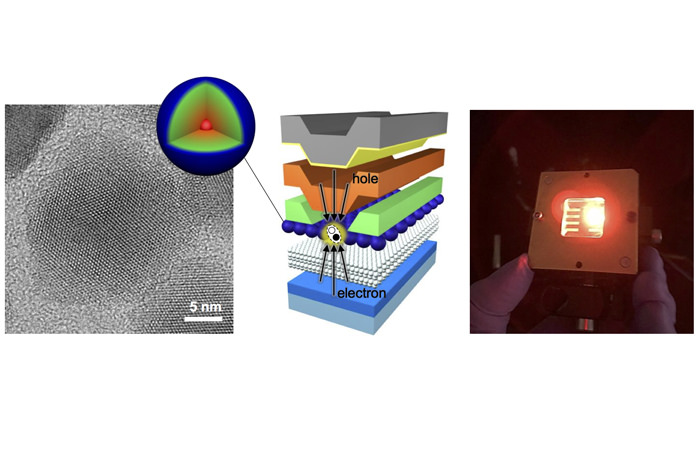By Jean-Jacques DeLisle, contributing writer
Current laser diode technologies use relatively expensive vacuum-based epitaxial techniques, a method which researchers have been striving to improve or replace for over a decade. Recently, researchers at the Los Alamos National Laboratory hit a breakthrough by achieving optical gain with solution-processable nanocrystal quantum-dot films. This breakthrough could eventually lead to the advent of much more efficient and powerful lasers that can operate over a wide range of wavelengths, as well as new laser applications, such as RGB laser modules for projectors and high-definition displays, and enhanced chemical diagnostics with multi-wavelength micro-lasers.

The collage above shows a transmission electron microscopy image of the improved quantum dot and its representation (left), the schematic of the device, which illustrates current-focusing idea (middle), and the device under operation (right.) Image source: lanl.gov news room.
“Optical gain with electrically excited quantum dots is now a reality,” said Victor Klimov, head of the quantum dot team at Los Alamos. “We have been working to develop new lasing media, using chemically synthesized quantum dots, although it had been widely believed that quantum-dot lasing with electrical stimulation is simply impossible. By using our specially designed dots, we can avoid energy losses created by Auger recombination.”
The Los Alamos team was able to demonstrate light amplification with a nanocrystal solid by use of direct-current electrical pumping. By developing a process that results in a material composition that is continuously varied along a radial direction, the researchers were able to eliminate sharp steps in the atomic composition that allow for Auger recombination.
The optical gain decay and waste heat generated from Auger recombination has been a major drawback of nanocrystal quantum dots for some time, as the slow process of electrical pumping for light amplification was necessarily compromised by this phenomenon. A research paper published in Nature Materials, also authored by Klimov in 2000, first shows optical gain in spite of Auger recombination, which provided evidence that eventually led to this latest discovery.
Another critical discovery of the Los Alamos research was the development of a current-focusing device. This new architecture enabled much higher current densities during the electrical pumping process, resulting in enhanced optical gains. Through the use of tapered charge-injection electrodes, the researchers were able to reduce the current-conducting area to less than 100 microns, thus concentrating the current enough to reach higher levels of light amplification without damaging the quantum dots or the injection layers.
Advertisement
Learn more about Electronic Products Magazine





